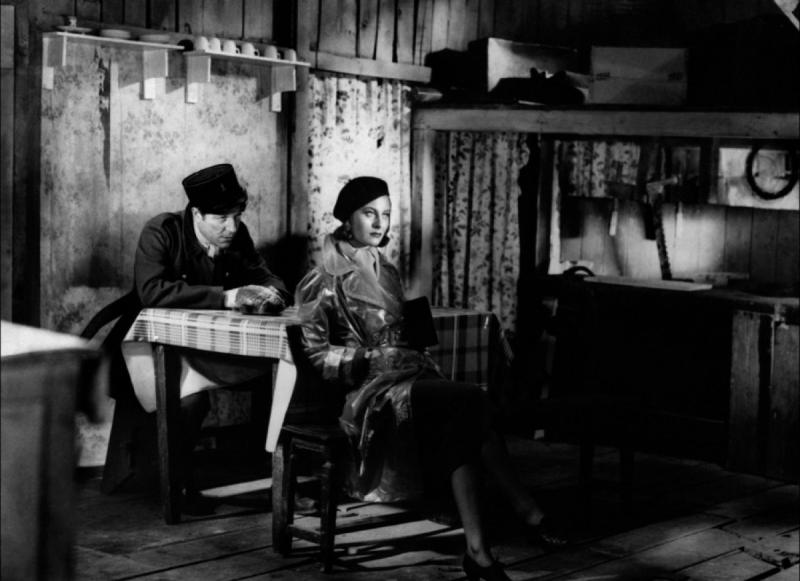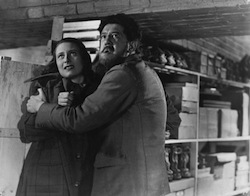Le Quai des brumes | reviews, news & interviews
Le Quai des brumes
Le Quai des brumes
Jean Gabin and Michèle Morgan give love a chance in the benighted Le Havre of a French poetic realist classic

“Atmosphère…atmosphère,” the tart played by Arletty barks at her boyfriend-pimp on a canal bridge in Marcel Carné’s 1938 Hôtel du Nord.
A sublimely melancholy story of alienation and doomed love starring Jean Gabin at his greatest and the revelatory Michèle Morgan (who at 17 was exactly half his age), it was the third collaboration between Carné and the brilliant, anarchic poet-screenwriter Jacques Prévert – dubbed “the film poet of revolt” by Ado Kyrou – who would eventually make eight great films together, seven in the poetic realist school that dominated French cinema from the mid Thirties through the mid Forties and forges a link between the German Kammerspielfilm and American film noir.
Zabel, we're not surprised to learn, has been putting the moves on Nelly
Defining poetic realism has been a tough nut for movie scholars to crack, but simply put it was a lyrical response to the fatalism and decay that was perceived to have engulfed the French working class and lower-middle class in the years leading up and during the war. Films made in this mode both captured the tides of social and political divisiveness and augured the agony of occupation and collaborationism. Alongside Jean Renoir’s Popular Front-influenced Le Crime de Monsieur Lange (1936), his Zola adaptation La Bête humaine (1938) and Carné and Prévert’s Le Jour se lève (1939), Le Quai des brumes sits at the apex of the movement.
It is an urban fairytale, adapted from a Pierre Mac Orlan novel, with a virgin, a shopworn prince, the beast he must rescue her from, and an impotent rival thrown in for good measure. An army deserter who has bitter experiences of killing people in Tonkin (northernmost Vietnam), world-weary Jean (Gabin) hitches a lift into Le Havre one night with a vague idea of finding a ship to take him abroad. Falling in with a drunk, he is led away from the city centre with its prowling military personnel to a harbour-side dive run by the former traveler Panama, a garrulous angel in a white suit.
 Among the lost souls who show up there is an iconoclastic painter – perhaps Prévert’s comment on the isolated role of the artist – who eventually bequeaths Jean his civvies when he drowns himself, and Zabel (Michel Simon), a cultured fancy-goods retailer, who has mysterious packages he wants to lose and is looking for Nelly, his teenage ward. The craven fallen bourgeois Lucien (Pierre Brasseur) and his crew of callow gangsters try to smoke out Zabel to get information from him about an associate who’s gone missing. In a backroom, Jean chances upon Nelly, who is the missing guy’s girlfriend and has run away from Zabel, who, we’re not surprised to learn, has been putting the moves on her (Morgan and Simon pictured above).
Among the lost souls who show up there is an iconoclastic painter – perhaps Prévert’s comment on the isolated role of the artist – who eventually bequeaths Jean his civvies when he drowns himself, and Zabel (Michel Simon), a cultured fancy-goods retailer, who has mysterious packages he wants to lose and is looking for Nelly, his teenage ward. The craven fallen bourgeois Lucien (Pierre Brasseur) and his crew of callow gangsters try to smoke out Zabel to get information from him about an associate who’s gone missing. In a backroom, Jean chances upon Nelly, who is the missing guy’s girlfriend and has run away from Zabel, who, we’re not surprised to learn, has been putting the moves on her (Morgan and Simon pictured above).
Jean catches sight of Nelly standing by a window in a see-through raincoat and a beret, faked dispassion written all over her face – the kind of great, iconically accessorized entrances grave-face dreamgirls don’t make anymore. Slowly, trustingly, the two get to know each other over the course of day. In the moral murk, amid such sordor, love gleams. The raincoat rematerialized as the plastic mac sported by Joan Bennett’s mercenary tramp in Scarlet Street (1945), Fritz Lang’s noir remake of Renoir’s La Chienne (1931).
Nelly isn’t a whore, though, but a virgin in need of Jean’s protection from the lusting Lucien and the odious Zabel (whose characterization smacks of anti-Semitism). She isn’t a virgin by the end of the picture; Eugen Schüfftan’s lambent morning-after shot of her in Jean’s bed all but banishes the gloom. Jean has also found a companion in the 1938 edition of Uggie. What’s more, a ship is leading for Venezuela, and Jean, with a new identity and passport, can be on it. When he gets there, he will send for Nelly. And, come September, it’s impossible that France and Britain will sell out Czechoslovakia to Hitler at Munich.
Jean has also found a companion in the 1938 edition of Uggie
Carné was grossly undervalued by the Cahiers du cinéma critics in the Fifties, his visualizations of Prévert’s screenplays considered mere embellishments of the writer’s imagistic scene-setting and pithily beautiful dialogue. But he placed the camera unerringly and moved it imaginatively, bringing quietly poetic cadences to the charged realism. He was also a great director of actors, even if that meant getting out of the way of old hands like the formidable Simon, Édouard Delmont, who played Panama, and Raymond Almos, who played the drunk. In his and Prévert’s hands, Le Quai des brumes’ hopeless love story offered a pessimistic analysis of a society in which class is pitted against class, families are incestuous, the bourgeoisie is decadent, and imperialism turns every poilu into a killer. No wonder the atmosphere is tainted.
- The newly restored Le Quai des blumes is on limited release
rating
Share this article
The future of Arts Journalism
You can stop theartsdesk.com closing!
We urgently need financing to survive. Our fundraising drive has thus far raised £49,000 but we need to reach £100,000 or we will be forced to close. Please contribute here: https://gofund.me/c3f6033d
And if you can forward this information to anyone who might assist, we’d be grateful.

Subscribe to theartsdesk.com
Thank you for continuing to read our work on theartsdesk.com. For unlimited access to every article in its entirety, including our archive of more than 15,000 pieces, we're asking for £5 per month or £40 per year. We feel it's a very good deal, and hope you do too.
To take a subscription now simply click here.
And if you're looking for that extra gift for a friend or family member, why not treat them to a theartsdesk.com gift subscription?
more Film
 Steve review - educator in crisis
Cillian Murphy excels as a troubled headmaster working with delinquent boys
Steve review - educator in crisis
Cillian Murphy excels as a troubled headmaster working with delinquent boys
 Can I get a Witness? review - time to die before you get old
Ann Marie Fleming directs Sandra Oh in dystopian fantasy that fails to ignite
Can I get a Witness? review - time to die before you get old
Ann Marie Fleming directs Sandra Oh in dystopian fantasy that fails to ignite
 Happyend review - the kids are never alright
In this futuristic blackboard jungle everything is a bit too manicured
Happyend review - the kids are never alright
In this futuristic blackboard jungle everything is a bit too manicured
 Robert Redford (1936-2025)
The star was more admired within the screen trade than by the critics
Robert Redford (1936-2025)
The star was more admired within the screen trade than by the critics
 Blu-ray: The Sons of Great Bear
DEFA's first 'Red Western': a revisionist take on colonial expansion
Blu-ray: The Sons of Great Bear
DEFA's first 'Red Western': a revisionist take on colonial expansion
 Spinal Tap II: The End Continues review - comedy rock band fails to revive past glories
Belated satirical sequel runs out of gas
Spinal Tap II: The End Continues review - comedy rock band fails to revive past glories
Belated satirical sequel runs out of gas
 Downton Abbey: The Grand Finale review - an attemptedly elegiac final chapter haunted by its past
Noel Coward is a welcome visitor to the insular world of the hit series
Downton Abbey: The Grand Finale review - an attemptedly elegiac final chapter haunted by its past
Noel Coward is a welcome visitor to the insular world of the hit series
 Islands review - sunshine noir serves an ace
Sam Riley is the holiday resort tennis pro in over his head
Islands review - sunshine noir serves an ace
Sam Riley is the holiday resort tennis pro in over his head
 theartsdesk Q&A: actor Sam Riley on playing a washed-up loner in the thriller 'Islands'
The actor discusses his love of self-destructive characters and the problem with fame
theartsdesk Q&A: actor Sam Riley on playing a washed-up loner in the thriller 'Islands'
The actor discusses his love of self-destructive characters and the problem with fame
 Honey Don’t! review - film noir in the bright sun
A Coen brother with a blood-simple gumshoe caper
Honey Don’t! review - film noir in the bright sun
A Coen brother with a blood-simple gumshoe caper
 The Courageous review - Ophélia Kolb excels as a single mother on the edge
Jasmin Gordon's directorial debut features strong performances but leaves too much unexplained
The Courageous review - Ophélia Kolb excels as a single mother on the edge
Jasmin Gordon's directorial debut features strong performances but leaves too much unexplained

Add comment